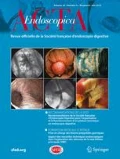Résumé
Lors de la résection endoscopique d’un polype difficile, après avoir accédé à la lésion, il faut se positionner de façon à avoir une utilisation optimale et donc plus sûre des instruments. L’utilisation des techniques de base permet la coloscopie complète dans plus de 90 % des cas. Le plus important est de réduire les boucles pour faciliter la progression et la résection. On distingue différents types de boucles dont la réduction nécessite une manœuvre spécifique. Ces différentes boucles ont été étudiées grâce à la radioscopie et aux appareils donnant une représentation de l’endoscope dans l’espace. La mobilisation du patient peut faciliter la progression ou la visualisation de la muqueuse. La pression abdominale peut être d’une aide précieuse pour atteindre le cæcum. L’utilisation d’overtubes, d’endoscopes à rigidité variable ou d’endoscopes à double ballon permet de pallier les échecs de la coloscopie standard. Une fois atteint, au moment de réséquer, il faut essayer de positionner le polype à six heures en appliquant une rotation à l’endoscope. Cette manœuvre est plus facile avec un endoscope débouclé. La rétrovision peut faciliter l’exposition d’un polype en particulier en sus anal, derrière un gros pli ou derrière la valvule. Elle est plus facile avec un endoscope souple comme un gastroscope ou un entéroscope à double ballon. Les gros polypes seront enlevés à la descente, ce qui permet de déboucler et d’éviter de réséquer un polype à proximité d’un cancer. L’utilisation de ces techniques permet un accès plus facile aux lésions, un meilleur positionnement et donc une résection dans des conditions plus sûres.
Abstract
During the endoscopic resection of a difficult polyp, after accessing the lesion, it is necessary to position so as to have an optimal use and thus more safe of instruments. Using basic techniques enables complete colonoscopy in more than 90% of cases. The most important technique is to reduce loops to facilitate the progress and the resection. There are different types of loops whose reduction requires a specific maneuver. The different loops have been studied by X-ray equipment and to the devices giving a representation of the endoscope in the space. Mobilizing the patient can facilitate the progression or visualization of the mucosa. The abdominal pressure can be a valuable aid to reach the cæcum. Using overtubes, endoscopes with variable stiffness or double-balloon endoscopes can compensate for failures of standard colonoscopy. Once reaches, before resection, it is necessary to try to position the polyp at 6 o’clock by applying a rotation to the endoscope. This operation is easier with an unbuckled endoscope. The retrovision may facilitate the exposure of a polyp near the anus, behind a big fold or behind the caecal valve. Large polyps are removed from the withdrawal with an unloop endoscope and to avoid resect a polyp near a cancer. Using these techniques allows easier access to lesions, better positioning and therefore resection in safer conditions can be achieved.
Références
Rex DK. Achieving cecal intubation in the very difficult colon. Gastrointest Endosc 2008;67(6):938–44.
Shah SG, Saunders BP, Brooker JC, Williams CB. Magnetic imaging of colonoscopy: an audit of looping, accuracy and ancillary maneuvers. Gastrointest Endosc 2000;52(1):1–8.
East JE, Suzuki N, Arebi N, Bassett P, Saunders BP. Position changes improve visibility during colonoscope withdrawal: a randomized, blinded, crossover trial. Gastrointest Endosc 2007;65(2):263–9.
Roberts-Thomson IC, Teo E. Colonoscopy: art or science? J Gastroenterol Hepatol 2009;24(2):180–4.
Ginsberg GG. Colonoscopy with the variable stiffness colonoscope. Gastrointest Endosc 2003;58(4):579–84.
Othman MO, Bradley AG, Choudhary A, Hoffman RM, Roy PK. Variable stiffness colonoscope versus regular adult colonoscope: meta-analysis of randomized controlled trials. Endoscopy 2009;41(1):17–24.
Yamamoto H, Sekine Y, Sato Y, Higashizawa T, Miyata T, Iino S, et al. Total enteroscopy with a nonsurgical steerable double-balloon method. Gastrointest Endosc 2001;53(2):216–20.
Gay G, Delvaux M. Double-balloon colonoscopy after failed conventional colonoscopy: a pilot series with a new instrument. Endoscopy 2007;39(9):788–92.
Author information
Authors and Affiliations
Corresponding author
About this article
Cite this article
Legros, R., Sautereau, D. Trucs et astuces à utiliser pour les difficultés liées à la localisation. Acta Endosc 40, 70–73 (2010). https://doi.org/10.1007/s10190-010-0036-9
Published:
Issue Date:
DOI: https://doi.org/10.1007/s10190-010-0036-9

